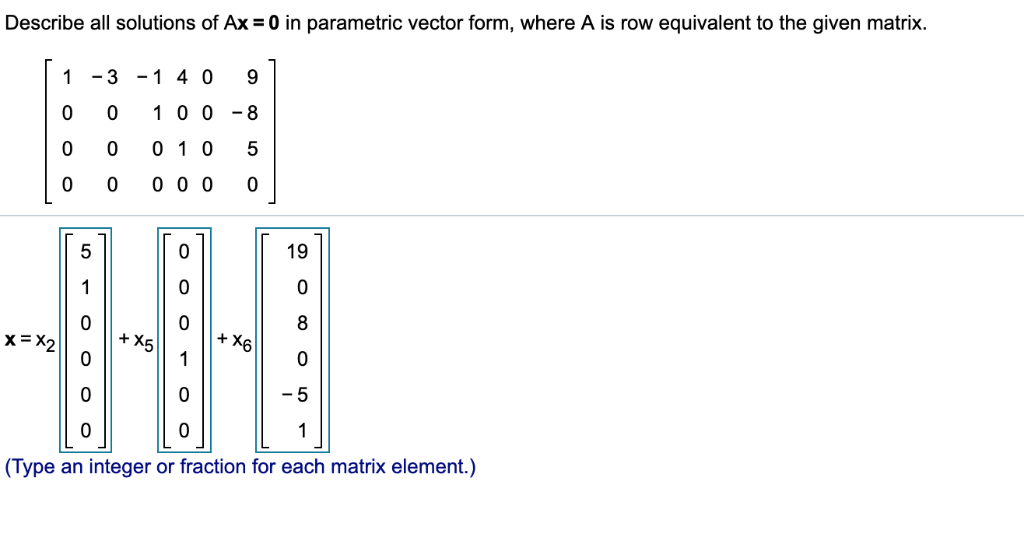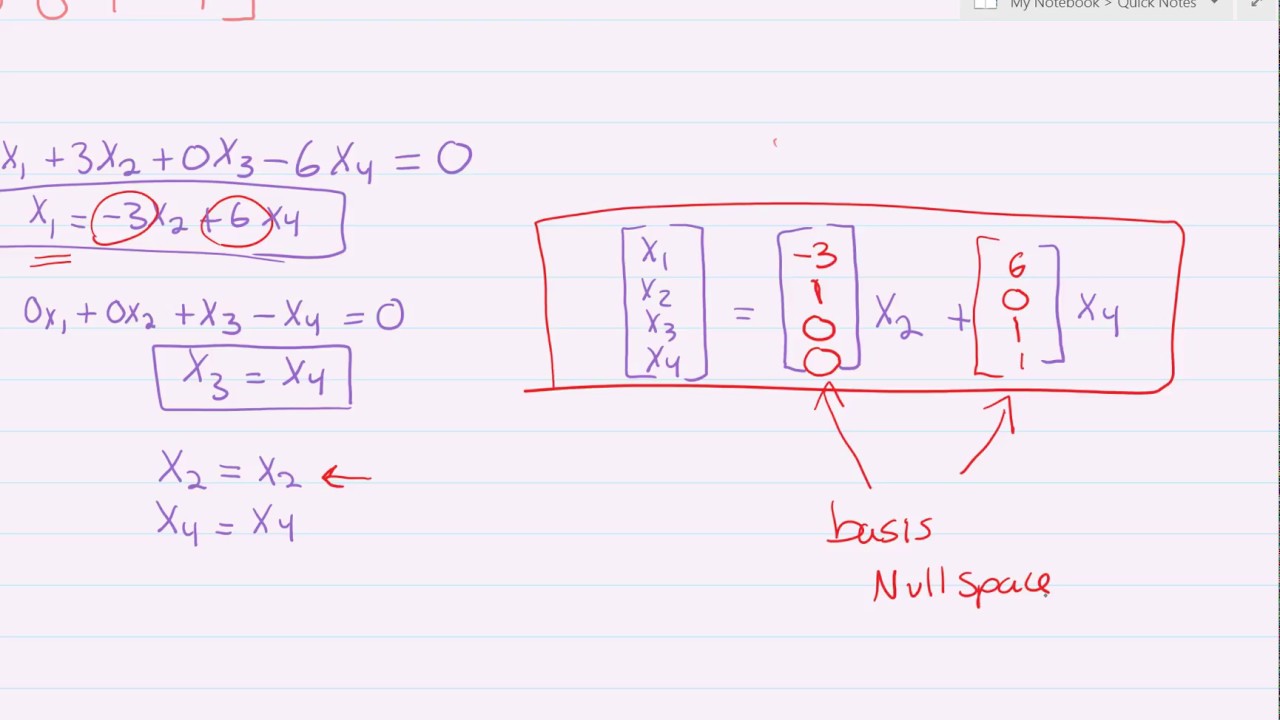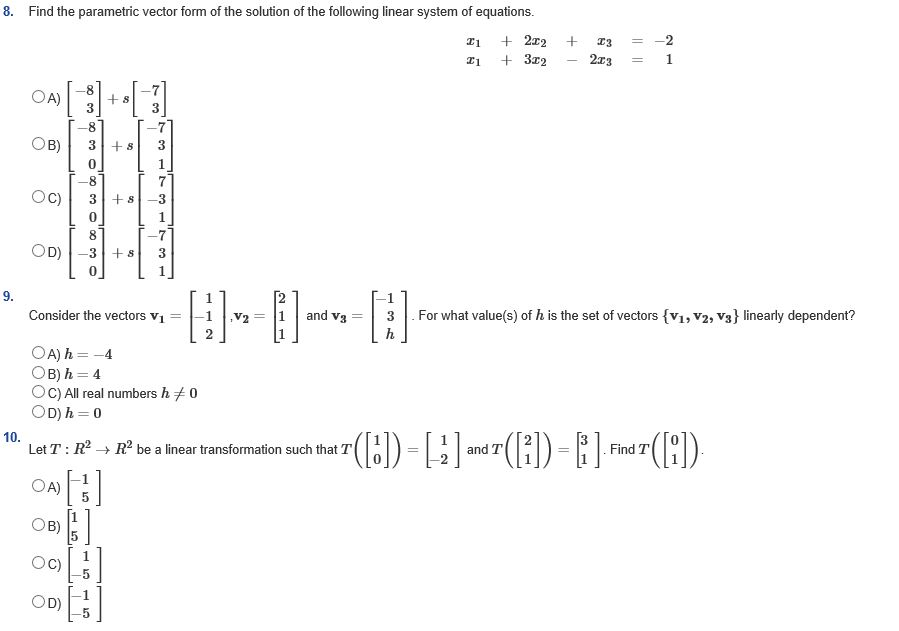Parametric Vector Form
Parametric Vector Form - (x, y, z) = (1 − 5z, − 1 − 2z, z) z any real number. X = ( x 1 x 2) = x 2 ( 3 1) + ( − 3 0). Web in this section we will derive the vector form and parametric form for the equation of lines in three dimensional space. Web this video shows an example of how to write the solution set of a system of linear equations in parametric vector form. Learn about these functions and how we apply the concepts of the derivative and the integral on them. Magnitude & direction to component. Web this is called the parametric vector form of the solution. And so, you must express the variables x1 and x2 in terms of x3 and x4 (free variables). Web this is called a parametric equation or a parametric vector form of the solution. In this case, the solution set can be written as span {v 3, v 6, v 8}.
(a) 1 2 2 4 # (b) 2 66 66 66 4 1 2 3 2 1 4 4 0 3 77 77 77 5 (c. And so, you must express the variables x1 and x2 in terms of x3 and x4 (free variables). Web the parametric form of the solution set of a consistent system of linear equations is obtained as follows. In this case, the solution set can be written as span {v 3, v 6, v 8}. This vector equation is called the parametric vector form of the solution set. Note as well that while these forms can also be useful for lines in two dimensional space. Web this is called the parametric vector form of the solution. The symmetric equations of a line are obtained by eliminating the parameter tfrom theparametric equations. Magnitude & direction to component. Sometimes the parametric equations for the individual scalar output variables are combined into a single parametric equation in vectors :
Web answering your question, you need a parametric vector solution set because the system of equations that is provided to you is underconstrained, that is, the number of variables is greater than the number of equations. If you have a general solution for example. Where $(x_0,y_0,z_0)$ is the starting position (vector) and $(a,b,c)$ is a direction vector of the line. Web adding vectors algebraically & graphically. Web you can almost always do this, and it's probably the easiest way to go. Web the parametric equations of the line are the components of the vector equation, and have theformx=x0+at, y=y0+bt, andz=z0+ct. (0, −3, 0) − (6, 0, 0) = (−6, −3, 0) ( 0, − 3, 0) − ( 6, 0, 0) = ( − 6, − 3, 0) (0, 0, 2) − (6, 0, 0) =. Multiplying a vector by a scalar. Web the one on the form $(x,y,z) = (x_0,y_0,z_0) + t (a,b,c)$. Matrix, the one with numbers, arranged with rows and columns, is extremely useful in most scientific fields.
Vector Parametric Form Flat Mathematics Stack Exchange
This vector equation is called the parametric vector form of the solution set. We write the solution set as. Can be written as follows: And so, you must express the variables x1 and x2 in terms of x3 and x4 (free variables). Web what is a parametric vector form?
4.2.3 Vector, Cartesian and Parametric Forms YouTube
(a) 1 2 2 4 # (b) 2 66 66 66 4 1 2 3 2 1 4 4 0 3 77 77 77 5 (c. Web the parametric equations of the line are the components of the vector equation, and have theformx=x0+at, y=y0+bt, andz=z0+ct. Sometimes the parametric equations for the individual scalar output variables are combined into a single.
Parametric Vector Form and Free Variables [Passing Linear Algebra
Web you can almost always do this, and it's probably the easiest way to go. The componentsa, bandcof vare called thedirection numbers of the line. A point ( x, y) is on the unit circle if and only if there is a value of t such that these two equations generate that point. Here is my working out: Wait a.
Solved Describe all solutions of Ax=0 in parametric vector
Web what is a parametric vector form? To find the vector equation of the line segment, we’ll convert its endpoints to their vector equivalents. Web you can almost always do this, and it's probably the easiest way to go. Web this video explains how to write the parametric vector form of a homogeneous system of equations, ax = 0. This.
Example Parametric Vector Form of Solution YouTube
The componentsa, bandcof vare called thedirection numbers of the line. A point ( x, y) is on the unit circle if and only if there is a value of t such that these two equations generate that point. I have found the cartesian equation, but cannot find the parametric vector form. Matrix, the one with numbers, arranged with rows and.
Sec 1.5 Rec parametric vector form YouTube
Web parametric forms in vector notation while you can certainly write parametric solutions in point notation, it turns out that vector notation is ideally suited to writing down parametric forms of solutions. The symmetric equations of a line are obtained by eliminating the parameter tfrom theparametric equations. Polar functions are graphed using polar coordinates, i.e., they take an angle as.
Parametric Vector at Collection of Parametric Vector
Web this video shows an example of how to write the solution set of a system of linear equations in parametric vector form. This vector equation is called the parametric vector form of the solution set. Can be written as follows: Span { ( 3 1) } + ( − 3 0). Web this is called the parametric vector form.
1.5 Parametric Vector FormSolving Ax=b in Parametric Vector Form
We emphasize the following fact in particular. Web we can write the parametric form as follows: Span { ( 3 1) } + ( − 3 0). Web the parametric form {x = 1 − 5z y = − 1 − 2z. Web the parametric equations of the line are the components of the vector equation, and have theformx=x0+at, y=y0+bt,.
Solved Find the parametric vector form of the solution of
Magnitude & direction to component. It is an expression that produces all points. { x 1 = 3 x 2 − 3 x 2 = x 2 + 0. Web this video shows an example of how to write the solution set of a system of linear equations in parametric vector form. Web answering your question, you need a parametric.
202.3d Parametric Vector Form YouTube
We turn the above system into a vector equation: We emphasize the following fact in particular. 1 find a parametric vector form for the solution set of the equation ax~ =~0 for the following matrices a: Polar functions are graphed using polar coordinates, i.e., they take an angle as an input and output a radius! Write the system as an.
The Set Of Solutions To A Homogeneous Equation Ax = 0 Is A Span.
X1 = 1 + 2λ , x2 = 3 + 4λ , x3 = 5 + 6λ , x 1 = 1 + 2 λ , x 2 = 3 + 4 λ , x 3 = 5 + 6 λ , then the parametric vector form would be. 1 find a parametric vector form for the solution set of the equation ax~ =~0 for the following matrices a: Web i know the vector form is x = p + td, p being a point on the line and d being a direction vector so i put it in the following form: And so, you must express the variables x1 and x2 in terms of x3 and x4 (free variables).
Magnitude & Direction To Component.
In this case, the solution set can be written as span {v 3, v 6, v 8}. Web this is called the parametric vector form of the solution. { x 1 = 3 x 2 − 3 x 2 = x 2 + 0. Web this video shows an example of how to write the solution set of a system of linear equations in parametric vector form.
If You Have A General Solution For Example.
Where $(x_0,y_0,z_0)$ is the starting position (vector) and $(a,b,c)$ is a direction vector of the line. Web you can almost always do this, and it's probably the easiest way to go. We emphasize the following fact in particular. Web finding vector and parametric equations from the endpoints of the line segment.
Web In This Section We Will Derive The Vector Form And Parametric Form For The Equation Of Lines In Three Dimensional Space.
Terminology is not altogether standard so check with your instructors. Polar functions are graphed using polar coordinates, i.e., they take an angle as an input and output a radius! (x, y, z) = (1 − 5z, − 1 − 2z, z) z any real number. Move all free variables to the right hand side of the equations.









